At this time, there is no unequivocal information about the exact mechanism of action of mephedrone. Despite this, in vitro activity of 4mmc is described by its interaction with the three major monoamine transporters (SERT, DAT, NET), serotonin 5-HT1A and 5-HT2A receptors, omega-1 receptors, as well as with α1- and α2-adrenoreceptors. Several different independent studies demonstrate the effect of mephedrone as a substrate of these transporters, which ultimately induces the release of the corresponding monoamines into the synaptic cleft, blocking their reuptake. At the level of dopaminergic nuclei, 4mmc activates the caudatus putamen and the ventral tegmental area (VTA). Also, mephedrone has a stimulating effect on the nucleus accumbens (core and shell). Furthermore, Grochecki showed a range of changes in the hippocampus of adolescent rats that can be detected after administration of mephedrone to adolescent rats, including elevated levels of matrix metalloprotease (MMP)-9, up-regulation of the NMDA receptor subunit GluN2B, and decreased levels of postsynaptic density protein (PSD)-95 levels. Mephedrone is capable of altering animal behavior in a variety of ways. Also, mephedrone has been shown to cause the following changes: hyperactivity, antidepressant-like effects, prodepressant effects, excessive salivation, aggressive behavior and self-harm6 improves visual-spatial memory and learning (impairs working and reference memory). Among other things, 4mmc can reduce weight gain, disrupts thermoregulation, causes long-term changes in the gut microbiome, and decreases social preference, causes behavioral sensitization to repetitive movements, and exhibits thermal antinociception.
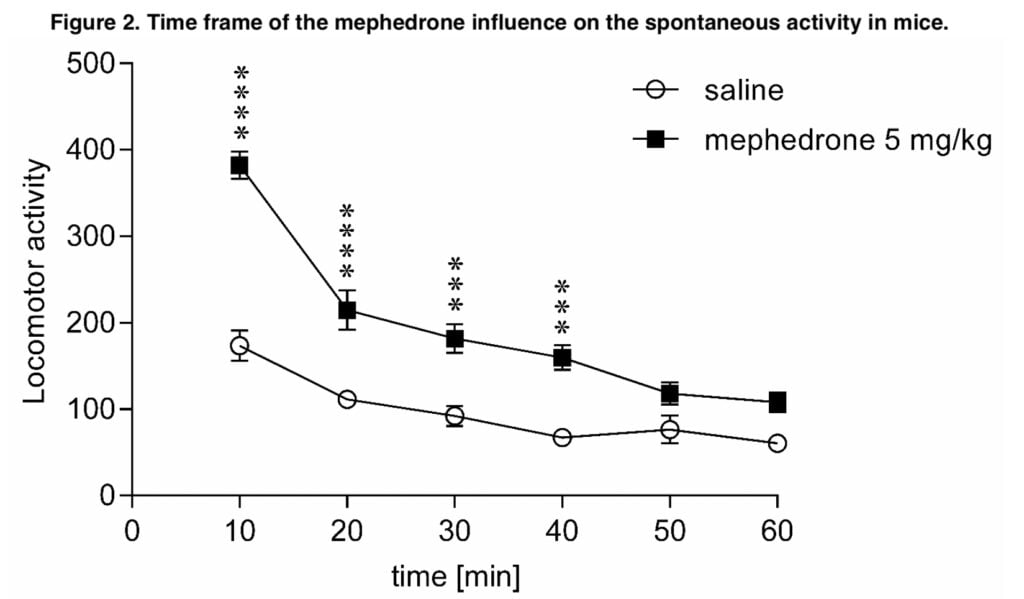
At this point, not all of the properties of mephedrone have yet been uncovered. There is not much information in the available scientific literature on behavioral experiments related to central effects. There is also a lot of inconsistency, which suggests that further research in this area is needed. Given the presented need for the development of this study, we have contributed to the knowledge of the effects of mephedrone on living organisms, as well as demonstrated additional properties of this substance. In our publication we describe the process of our study on albino mice, which were subjected to certain behavioral tests: measurement of spontaneous motor activity; rotarod and chimney tests; “elevated plus maze” test; modified EPM; seizure test with pentylentetrazole. The results thus provide a better understanding of the biological effects of mephedrone.
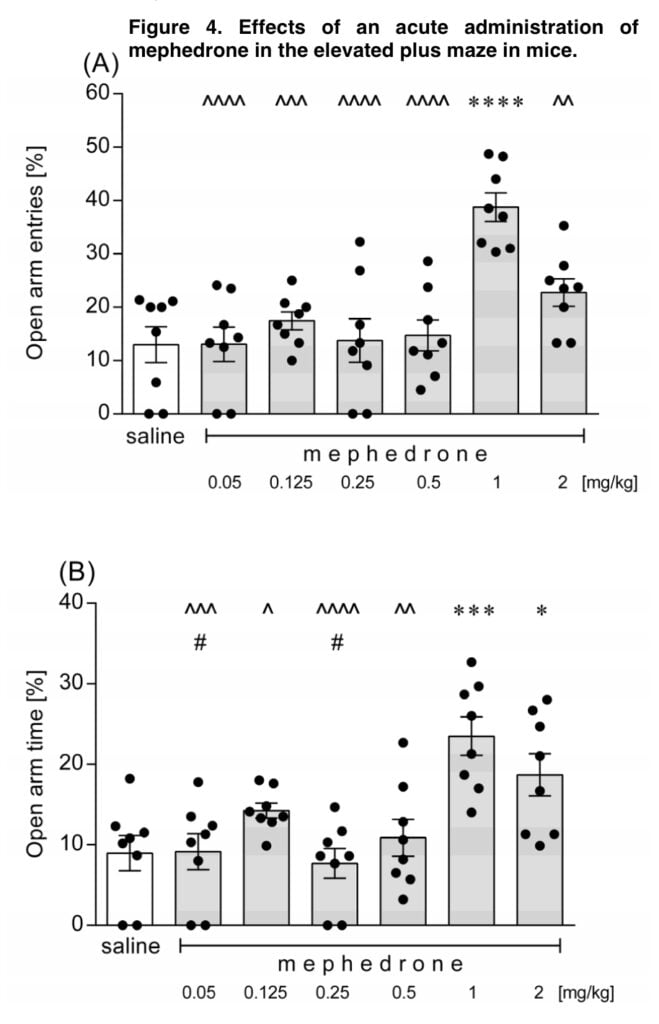
Research methodology and laboratory materials used
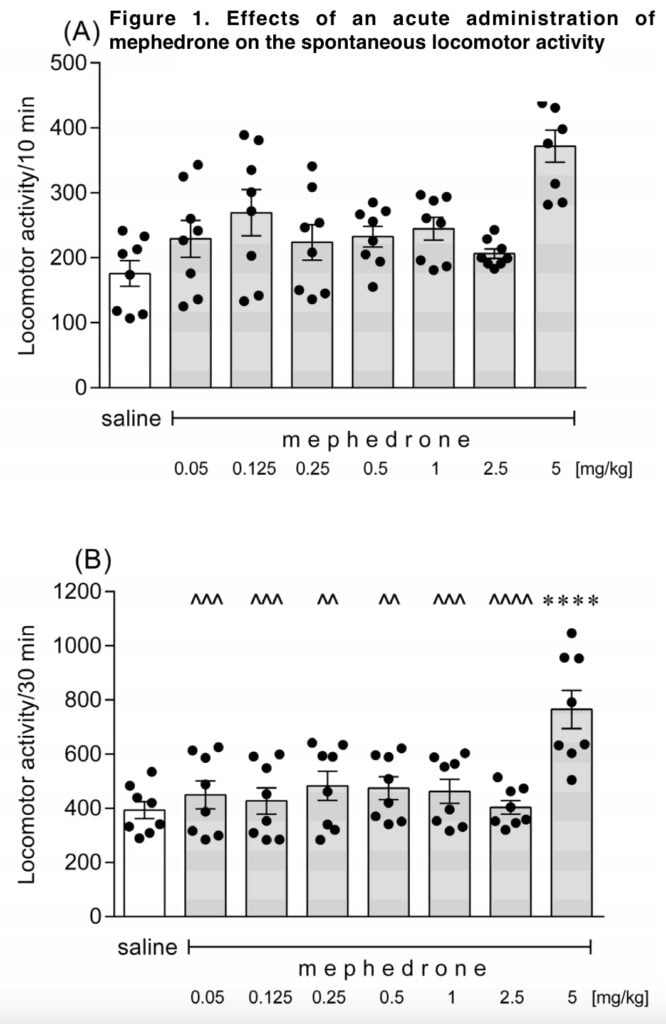
- The study was conducted on Swiss albino mice weighing 20-25 g.
- The substance used was mephedrone (((RS)-2-methylamino-1-(4-methylphenyl) propan-1-one and pentylenetetrazole, which was injected intraperitoneally.
- Locomotor activity was investigated by means of a photocell placed in an experimental room with soundproofing.
- The rotarod test was performed after three days of training mice on a rotating rod at a speed of 18 revolutions per minute. Directly in the experiment, mice were placed there for three minutes and parameters, including the duration of stay on the rotating rod, were recorded.
- The chimney test was performed 20 minutes after administration of 4mmc (in dosages of 0.125; 0.25; 0.5 and 1 ml/kg), the experimental session lasted for 60 seconds.
- The EMP test was performed in a black Plexiglas maze with a central platform and two open arms (measuring 30×5 cm), the height of the maze being 50 cm above the floor. Video camera detection was performed, and the number of entries into the open arms and the time spent in the open arms with identification of the anxiolytic/anxiolytic potential were measured.
- The NOR test was conducted in an open-field box with an illuminance of 25 W. After the test, the preference index (PI) was calculated using the formula.
- An animal model of PTZ epilepsy was induced using the following doses of mephedrone: 1.25, 2.5, 5 mg/kg.
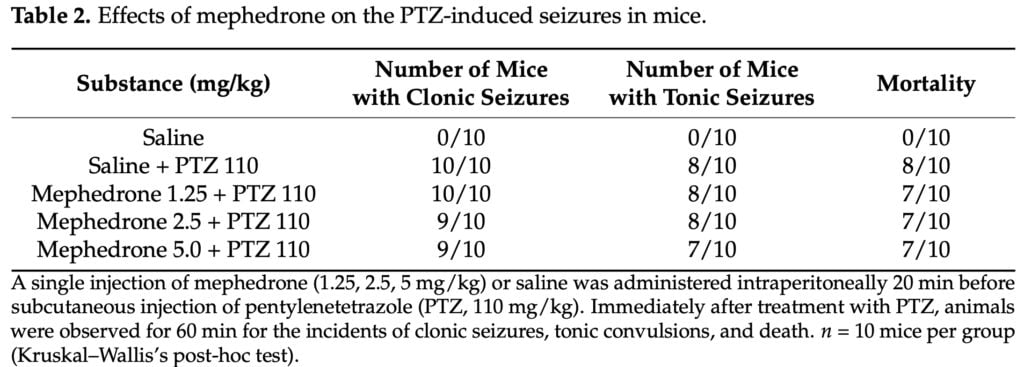
Discussion and debriefing
In our study, after administering high doses of mephedrone, the animals studied exhibited hyperactivity in a dose-dependent manner. The most active dose was 5 mg/kg, and doses from 0.05 to 2.5 mg.kg were ineffective. Based on the literature, the intensity of hyperlocomotion after mephedrone administration may be comparable to that observed after an equivalent dose of MDMA, but milder relative to the administration of classical amphetamine hydrochloride. The functional observational battery (FOB) carried out by Marusich in ICR mice revealed that the mephedrone-related activation of the spontaneous locomotion in animals may be accompanied by general stimulation (i.e., tense body, sudden darting), increased stereotyped head weaving and increased head circling. Despite this, some studies show that mephedrone does not always increase locomotor activity.
In the results of the next stages of our study, we confirmed that mephedrone crosses the blood-brain barrier very easily and quickly peaks in the brain. The effects of mephedrone are transient and short-lived. For example, the motor activity of the test mice returns to control values as early as 50 minutes after injection. Our observations are consistent with those obtained in a study on a human population, where mephedrone’s rapid metabolism and short half-life were confirmed. The desired effects of 4mmc appear 15 to 45 minutes after oral intake and a few minutes after intranasal insufflation, and after intravenous use, the desired effects may disappear within 30 minutes after injection. This may explain the constant repetition of mephedrone doses as opposed to cocaine use.
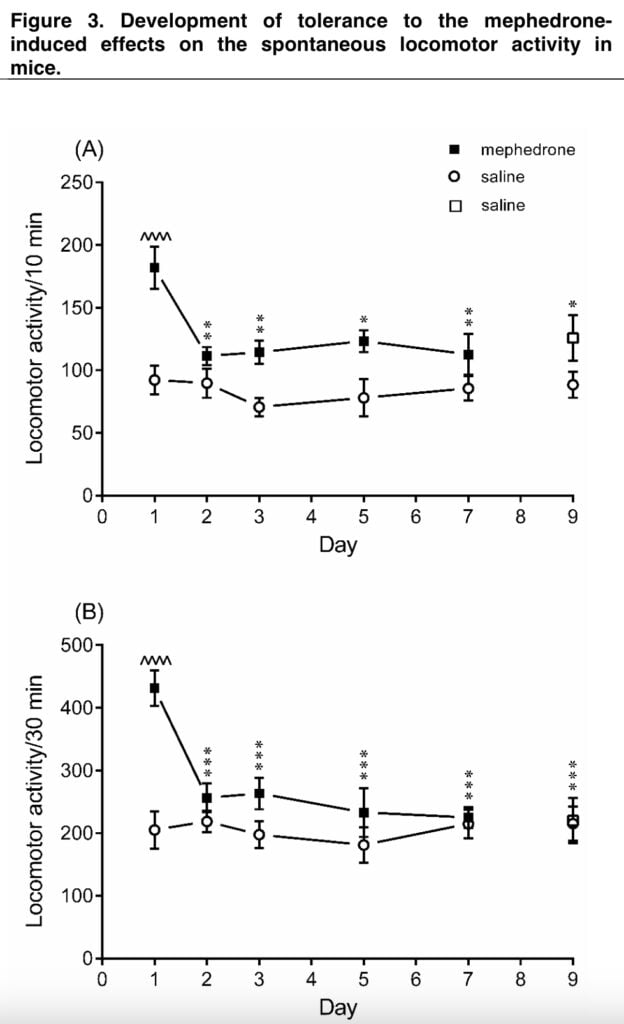
The increase in locomotor activity we observed was explained by changes in the serotonergic and dopaminergic system, as antagonism to 5- HT1A, 5-HT1B, and 5-HT2 receptors via WAY-100635, GR 127935, and ketanserin, as well as pretreatment with haloperidol and SCH23390 prevented hyperlocomotion. The results of the third phase of our experiment demonstrated that the use of mephedrone for several days leads to the development of tolerance and ambulatory hyperactivity. Tolerance is defined as a smooth decrease in the effect of a particular agent when repeatedly administered. Tolerance to the central effects of other psychostimulants is a widely described phenomenon, but little is known about the potential development of tolerance to effects induced by mephedrone. Furthermore, the development of tolerance to the effects of different cathinone stereoisomers has been observed in preclinical studies as well. Determination of mechanisms/pathways involved in the development of tolerance to mephedrone-induced hyperlocomotion could cast a new light on dependence and/or addiction to this drug. In our experiment, a second intraperitoneal dose of mephedrone administered 24 hours after the first did not statistically significantly increase the motility of the animals, an identical trend was observed after each subsequent injection. However, we did not find the development of withdrawal effects after stopping the use of mephedrone. To date, there are sporadic reports of mephedrone tolerance in animals, although tolerance can indeed develop with long-term use, as confirmed by many sources from private human case reports. In terms of the evidence base, for example, in the Shortall study, “bring-style” mephedrone administration causes reproducible hyperactivity after each dose. The endogenous kappa-opioid pathways and the dopaminergic system were assumed to be the main contributors to the development of mephedrone tolerance. However, we found that other neurotransmissions also contribute to this process in some way. In the chimney and rotarod tests, which assess the sense of balance and the effect of the injected drug on muscle relaxation, we found that none of the doses of mephedrone tested disrupted the animals’ motor coordination or caused myorelaxation. This is consistent with the results obtained in other studies, which found that mephedrone in the dose range from 3 to 56 mg/kg had no effect on the behavior of ICR mice on rotarod.
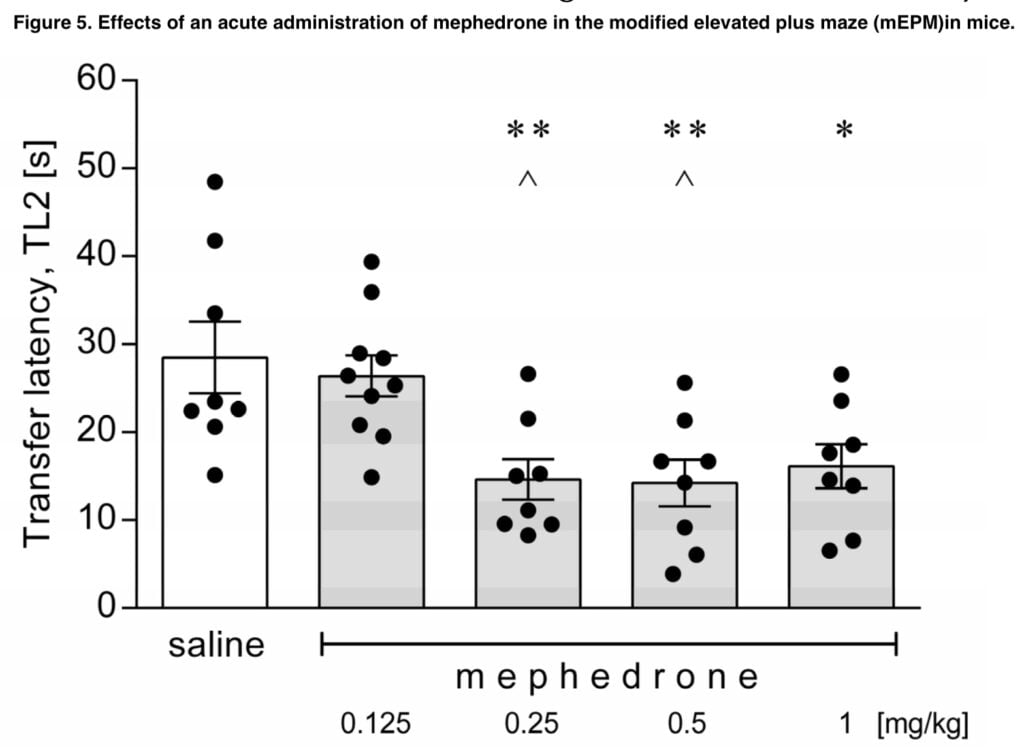
The behavior of animals in the EMP test is based on the innate conflict between preference for safe places and the natural motivation to explore new areas, even if they are potentially uncomfortable. This test is used to assess the anxiogenic potential of mephedrone in preclinical studies. In our experiment, mephedrone demonstrated dose-dependent anxiolytic potential. At doses of 1 and 2 mg/kg, mephedrone showed a prolongation of the time the animals spent in open space. Active central zone studies show a decrease in anxiety levels, which is usually seen with low doses, and a more pronounced tigmotaxis is noted after the highest dose of the drug of 20 mg/kg. Anxiety is one of the adverse reactions of mephedrone. In the mEPM and NOR tests with the injection of mephedrone 20 minutes before the memory acquisition session was identified in the retention/test session. The results suggest that 4mmc does not affect recognition memory, but improves spatial memory in a dose-dependent manner. Higher doses caused a significant shortening of the transfer latency during the retention session in the mEPM, and the lowest dose used (0.125 mg/kg) was ineffective. According to the literature as well as the results of the present study, it can be assumed that mephedrone affects different types of memory differently in different laboratory animals. After using mephedrone, there is a loss of concentration and memory, as well as impaired acute working memory and cognitive abilities in general. Most probably, MMP-2 and MMP-9 present in different brain regions are implicated in mephedrone’s activity toward memory processes. Mephedrone effects on learning are inconclusive, and they depend on various factors, including the age of a tested animal, its species, dosing schedule.
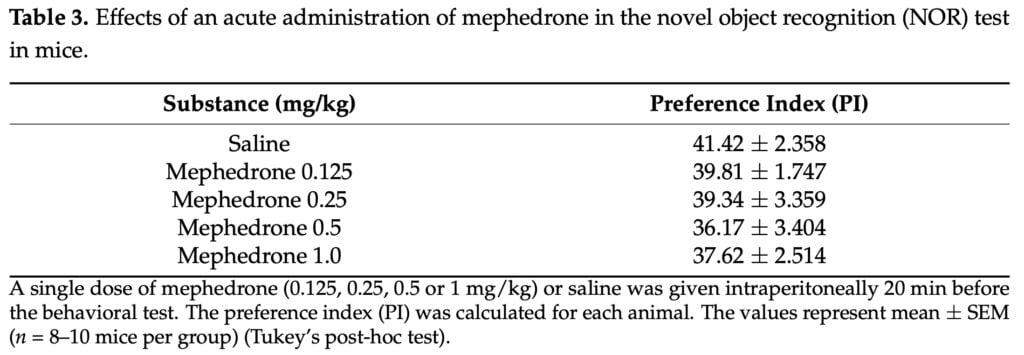
Conclusion
The main above results of our study contribute enormously to the general presentation of the central effects of mephedrone. We have shown that acute administration of mephedrone does not affect motor coordination, but may have anxiolytic potential, and does not cause anticonvulsant effects and does not affect recognition memory (while improving spatial memory). The ambulatory hyperactivity resulting from mephedrone use is rapid and short-lived, and repeated use of this cathinone leads to the development of tolerance.
